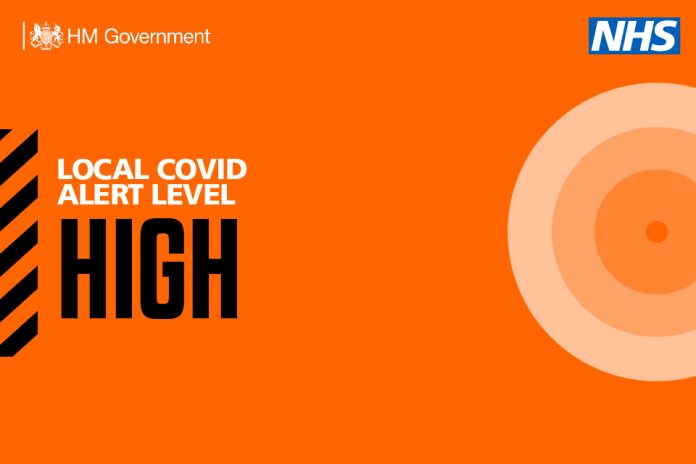After close discussions with local leaders, the following areas will move from local COVID alert level medium to local COVID alert level high from Saturday 24 October:
- Coventry
- Slough
- Stoke-on-Trent
This means that for these areas, the following measures will be in place:
- people must not meet with anybody outside their household or support bubble in any indoor setting, whether at home or in a public place
- people must not meet in a group of more than 6 outside, including in a garden or other space
- people should aim to reduce the number of journeys they make where possible; if they need to travel, they should walk or cycle where possible, or plan ahead and avoid busy times and routes on public transport
These measures will be reviewed every 14 days to consider whether they are still appropriate.
The government brought in legislation in July to give local authorities powers to impose restrictions, close premises or cancel events. Following discussions and feedback from local authorities in England, stronger regulations will now be put in place so local authorities can act without undue delay, rapidly shutting premises on public health grounds to stop the spread of the virus. A consultation on these proposals is ongoing with local authorities.
The rate of COVID-19 infections is rising rapidly across the UK. The weekly case rate in England stood at 172 people per 100,000 from 10 October to 16 October, up from 100 people per 100,000 for the week 25 September to 1 October. Cases are not evenly spread, with infection rates rising more rapidly in some areas than others.
In Coventry, weekly case rates are at 182 people per 100,000 and this increases to 946 per 100,000 in those aged 17 to 21 and is 76 per 100,000 in the over 60s.
In Slough, weekly case rates are at 141 people per 100,000 and this increases to 342 per 100,000 in those aged 17 to 21 and is 116 per 100,000 in the over 60s.
In Stoke-on-Trent, weekly case rates are at 173 people per 100,000 and this increases to 297 per 100,000 in those aged 17 to 21 and is 131 per 100,000 in the over 60s.
In addition to today’s announcement, discussions are ongoing with the following areas about moving to local COVID alert level very high:
- Nottingham City and parts of Nottinghamshire (Nottingham City Council, Broxtowe Borough Council, Gedling Borough Council, Rushcliffe Borough Council)
- West Yorkshire (Bradford, Leeds, Kirklees, Calderdale, Wakefield)
- North East (Newcastle upon Tyne, South Tyneside, Sunderland, Gateshead, North Tyneside, Northumberland, Country Durham)
- Tees Valley (Darlington, Middlesbrough, Hartlepool, Stockton on Tees, Redcar and Cleveland)
Speaking in the House of Commons, Health and Social Care Secretary Matt Hancock said:
Unfortunately, we are seeing rising rates of infection in Stoke-on-Trent, Coventry and in Slough. In all these areas, there are over 100 positive cases per 100,000 people.
Cases are doubling around every fortnight and we are seeing a concerning increase of cases among the over 60s.
So we have agreed, in partnership with local leaders, to move these areas into the high local alert level area, coming into force at one minute past midnight on Saturday.
I’d like to thank local leaders in these areas for the work that they’ve done, for their cooperation, and I can assure the people of Stoke-on-Trent, of Coventry and of Slough that we will support you all the way through.
All available data for the areas has been assessed by the government, including the Health and Social Care Secretary, NHS Test and Trace, the Joint Biosecurity Centre (JBC), Public Health England (PHE), the Chief Medical Officer and the Cabinet Office. Data assessed includes incidence, test positivity and the growth rate of the virus.
It is essential that outbreaks are contained to protect lives and our NHS, and prevent greater economic damage in the future. The country faces a new challenge as winter approaches, and even mild cases of COVID-19 can have devastating consequences for people in all age groups, along with the risk of long COVID.
The government’s strategy is to suppress the virus while supporting the economy, education and the NHS, until an effective vaccine is widely available.
Local action is at the centre of the government’s response, and engagement with local authorities is, and will continue to be, a key part of this process.
Background information
Latest infection rates per 100,000 people for week 10 October 2020 to 16 October 2020:
- Coventry: 182
- Stoke-on-Trent: 173
- Slough: 141
On 12 October, the government introduced a new, simplified framework for local interventions based around 3 new local COVID alert levels.
The postcode checker shows which alert level applies in each area. The NHS COVID-19 app will also direct people to this information.
We have provided £3.7 billion of funding to local authorities in England to respond to pressures in all their services.
The Prime Minister also announced on Monday 12 October additional COVID funding of around £1 billion which will provide local authorities with additional money to protect vital services. The government will set out further information in due course on how this new funding will be allocated.
Throughout the pandemic, the government has listened carefully to the views of the scientific community, in particular the information from the Scientific Advisory Group for Emergencies (SAGE) and its sub-groups when taking decisions on the best way to tackle the pandemic.







